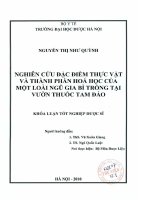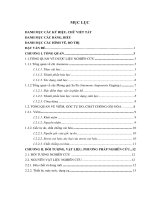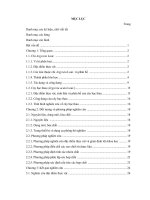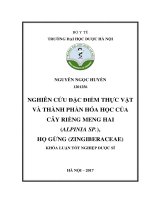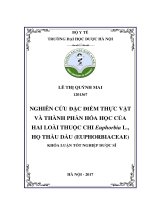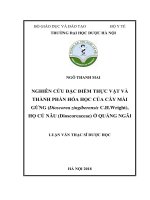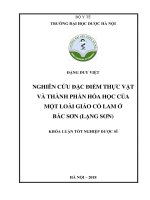- Trang chủ >>
- Sư phạm >>
- Sư phạm toán
ĐẠI HỌC HUẾ TRỜNG ĐẠI HỌC KHOA HỌC NGHIÊN CỨU ĐẶC ĐIỂM THỰC VẬT HỌC, SINH LÝ, HÓA SINH VÀ NHÂN GIỐNG IN VITRO MỘT SỐ GIỐNG SEN (NELUMBO NUCIFERA GAERTN ) TRỒNG Ở THỪA THIÊN HUẾ ĐIỂM CAO
Bạn đang xem bản rút gọn của tài liệu. Xem và tải ngay bản đầy đủ của tài liệu tại đây (1.78 MB, 56 trang )
HUE UNIVERSITY
UNIVERSITY OF SCIENCES
NGUYEN THI QUYNH TRANG
STUDY CHARACTERISTICS OF BOTANY,
PHYSIOLOGY, BIOCHEMISTRY AND IN VITRO
PROPAGATION OF SOME LOTUS VARIETIES
(NELUMBO NUCIFERA GAERTN.) GROWN IN
THUA THIEN HUE
Major: Plant Physiology
No.: 94.20.112
PH. D. THESIS OF BIOLOGY
Hue, 2021
The research was completed at:
Biology Department
University of Sciences, Hue University
Supervisors:
1. Assoc. Prof. Hoang Thi Kim Hong
2. Assoc. Prof. Vo Thi Mai Huong
Reviewer 1:.....................................................................
Reviewer 2: ....................................................................
Reviewer 3: ....................................................................
Thesis will be presented at the Hue University Examination Committee
Meeting at … date … month … year 2021
The thesis can be found at:
1. National Library of Vietnam
2. Library Information Center of University of Sciences, Hue
University
PUBLICATIONS RELATED TO THE THESIS
1. Nguyen Thi Quynh Trang, Hoang Thi Kim Hong, Vo Thi Mai
Huong (2017). Investigation of production status of Lotus (Nelumbo
Nucifera Gaertn) in Thua Thien Hue province. 2nd National Plant
Physiology Scientific Conference (Plant physiology applied in high-tech
agriculture). 1(1): 121-130.
2. Nguyen Thi Quynh Trang, Đang Thanh Long, Hoang Thi Kim
Hong (2018). In vitro propagation of Hue’s white concave lotus
(Nelumbo Nucifera Gaertn) from fresh seed. 2nd National Biotechnology
Conferency, 1267-1274.
3. Nguyen Thi Quynh Trang, Hoang Thi Kim Hong, Vo Thi Mai
Huong, Bui Ninh, Ngo Quy Thao Ngoc (2018). Morphological
characteristics, growth, development, and productivity of High-yield
Lotus cultivated in Thua Thien Hue province. Hue University Journal
of Science: Natural Science, 1(127): 192-202.
4. Nguyen Thi Quynh Trang, Hoang Thi Kim Hong, Đang Thanh
Long, Tran Thi Huong Giang, Tran Thi My Loan (2018). Study on the
distribution map of lotus varieties in Thua Thien Hue province. Journal
of Science and Technology, Hue University of Sciences, 13(2):165-176.
5. Nguyen Thi Quynh Trang, Trương Thi Hieu Thao, Hoang Thi Kim
Hong (2019). Study on the anatomical morphology of Lotus varieties
(Nelumbo nucifera Gaertn.) in Viet Nam. Plant cell Biotechnology and
Molecular Biology, 20(3&4): 95-105.
6. Nguyễn Thị Quỳnh Trang, Đang Thanh Long, Vo Thi Mai Huong,
Hoang Thi Kim Hong (2019). Agrobiological characteristics of lotus
cultivated in Thua Thien Hue province. Science and Technology
Juornal af Agriculture & Rural Development,13: 46-54.
7. Nguyen Thi Quynh Trang, Hoang Thi Kim Hong, Vo Thi Mai
Huong, Dang Thanh Long (2020). In vitro propagation of red lotus
(Nelumbo nucifera Gaertn) - an aquatic edible plant in Vietnam.
Agriculture Science Digest. 10.18805/ag.D-257 (Online First Article).
INTRODUCTION
1. The necessity of the thesis
Lotus (Nelumbo nucifera Gaertn.) is a potential perennial aquatic
plant, commonly grown in many countries all over the world. In
Vietnam, lotus is grown populary in the countryside.
Lotus is valuable aquatic plant, not only as a food and ornamental
flower but also as a source of herbal medicine. Almost every parts of
lotus can be used for different purposes.
In Thua Thien Hue, the capital city of Vietnam in the old days,
lotus is associated with several famous sights, such as the Imperial City,
the King’s tombs, pagodas and temples. Lotus is considered to
contribute to the unique beauty of Hue’s architecture by adding a soft
and graceful touch on these places. The values of the lotus are even
more significant to Hue inner city, where the Imperial City, a UNESCO
World Heritage, is located. In this area, lotus brings much more than
just a materialistic value. It is also a sparitual symbol representing
Buddhism spirit. Lotus is a Buddhism symbol, which is dedicated for
worshipping purpose in the most solemn places.
However, in recent years, lotus varieties with precious
characteristics are seriously declining and facing the risk of
disappearing over time. In Thua Thien Hue, there is not much research
on lotus. The existing ones mainly focus on the fields of food and
medicinal products. Collecting, conserving and evaluating the lotus
group based on the distribution and biological characteristics of the
variety and propagation of lotus plants by tissue-cell culture techniques
have not been given adequate attention in Thua Thien Hue. Therefore, it
is necessary to study about lotus conglomerate in Thua Thien Hue to
provide full descriptive data for research and management, to evaluate
botanical, physiological, biochemical characteristics, yield and quality
1
of lotus varieties. This is an indispensable and urgent job for the
conservation and exploitation of lotus resources in the current economy.
Based on this rationale, we chose the desertaion entitled “Study
characteristics of botany, physiology, biochemistry and in vitro
propagation of some lotus varieties (Nelumbo nucifera Gaertn.)
grown in Thua Thien Hue”. This study provides important database
about biochemical characteristics of different lotus varieties and in vitro
propagation plants for the conservation and development of local lotus
varieties in Thua Thien Hue province.
2. OBJECTIVES OF STUDY
2.1. General objectives
Identify the botanical, physiological, biochemical characteristics
and in vitro propagation of some major lotus varieties grown in Thua
Thien Hue to serve as the basis for the conservation of lotus genetic
resources and effective development of lotus plants in Thưa Thien Hue.
2.2. Detailed objectives
- To evaluate the current status of lotus production and to build
distribution diagram of lotus varieties grown in Thua Thien Hue.
- To evaluate genetic diversity based on the phenotype of lotus
varieties grown in Thua Thien Hue to provide a scientific basis for the
identification of lotus varieties.
- To evaluate the botanical characteristics (including internal and
external morphology) of lotus varieties for the purpose of identifying
and distinguishing lotus varieties.
- To provide database on physiological characteristics (growth,
development, yield) and biochemistry of some major lotus varieties in
Thua Thien Hue.
- To research on in vitro propagation of some local lotus varieties,
providing basis for the conservation and development of local lotus
varieties in Thua Thien Hue province.
2
3. Key findings
- The research identified a group of 66 lotus varieties belonging
to 6 main lotus varieties currently being grown in Thua Thien Hue
(including 1 non-local lotus variety and 5 local lotus varieties) with
complete data on distribution and description data. This is improtant
genetic material resource for the conservation, exploitation and
utilization of lotus genetic resources in Thua Thien Hue.
- The research evaluated genetic diversity based on some
phenotypes of 66 lotus varieties, providing a reliable scientific basis for the
identification of the main cultivated lotus varieties in Thua Thien Hue.
- The thesis fully and systematically evaluated the botanical,
physiological and biochemical characteristics of 6 main lotus varieties
in Thua Thien Hue such as morphological characteristics, anatomical
features; growth and development characteristics; seed yield and
quality. These research results have added new and valuable scientific
data for the conservation and rational exploitation of lotus genetic
resources in Thua Thien Hue.
- The research introduced 2 local lotus varieties with many
valuable characteristics such as flower color, yield and seed quality,
with potentials in production and market advantage, namely Convex
White Lotus variety and Light Red Lotus variety for preservation,
exploitation and development.
- The research initially successfully researched the in vitro
propagation of two precious lotus varieties, the Convex White Lotus
and the Light Red Lotus from lotus embryo. This result contributes to
the conservation and restoration of degraded precious lotus varieties in
Thua Thien Hue.
4. The overall structure of the thesis
There were 150 pages, divided into sections: Forewords, 4 pages;
Chapter 1: Literature review, 30 pages; Chapter 2: Materials, contents
and methods, 18 pages; Chapter 3: Results and Discussion, 82 pages;
Conclusions and recommendations, 2 pages; Section: List of publication
3
related to the dissertation, 1 page; Section: Reference, 13 pages with
127 reference documents in Vietnamese, English and from the internet.
The thesis includes 43 tables and 42 figures.
Chapter I. LITERATURE REVIEW
The thesis referred and summarized on 4 main issues related to:
(1) Overview of the lotus; (2) Situation of research on the lotus in the
world and Vietnam; (3) lotus planting and care techniques; (4) plant cell
tissue culture.
Chapter II. MATERIALS, CONTENTS AND METHODS
2.1. MATERIALS
Materials used to study botanical, physiological and biochemical
characteristics are 6 lotus varieties, selected from 66 lotus varieties
including 5 local lotus varieties: Gia Long Pink Lotus, Phu Mong Pink
Lotus, Light Red Lotus (Vinh Thanh Red Lotus), Concave White Lotus,
Convex White Lotus and the High-yield Lotus that
originated in Dong Thap.
Materials used in the study of in vitro propagation is mature lotus
seeds (23 to 25 days old) of 2 lotus varieties: Concave White Lotus and
Light Red Lotus.
2.2. RESEARCH CONTENTS
2.2.1. Investigation of production and consumption status of lotus,
building distribution diagram of lotus varieties in Thua Thien Hue
2.2.2. Study on genetic diversity based on morphological characteristics
of lotus varieties - Evaluating the starting material
2.2.3. Study on the botanical characteristics of some lotus varieties in
Thua Thien Hue
2.2.4. Study on the physiological characteristics of some lotus varieties
in Thua Thien Hue
2.2.5. Study on the biochemical characteristics of some lotus varieties in
Thua Thien Hue
4
2.2.6. In vitro propagation of selected local lotus varieties
2.3. Research methods
2.3.1. Investigation of production and consumption status of lotus,
building distribution diagram of lotus varieties in Thua Thien Hue
Investigation of production and consumption status of lotus
Building distribution diagram of lotus varieties in Thua Thien Hue
2.3.2. Study on genetic diversity based on morphological
characteristics of lotus samples varieties
2.3.3. Collection method of lotus varieties – material creation
2.3.4. Method of study on the botanical, physiological, biochemical
characteristics of some lotus varieties in Thua Thien Hue
Design of experiments
Study on the botanical characteristics of some lotus varieties
Study on the physiological characteristics of some lotus varieties
Study on the biochemical characteristics of some lotus varieties
2.3.5. Study on in vitro propagation of some local lotus varieties
2.3.6. Data analysis
Chapter III. RESULTS AND DISCUSSION
3.1. CURRENT STATUS OF PRODUCTION AND
CONSUMPTION OF LOTUS VARIETIES IN THUA THIEN
HUE
3.1.1. Location and composition of lotus varieties grown in Thua
Thien Hue
In 2017-2018, Thua Thien Hue had 66 lotus planting sites with
66 lotus varieties, divided into 2 groups: non-local lotus group (High-
yield Lotus variety), local lotus group with 2 sub-groups: the pink lotus
group (3 varieties: Gia Long Pink Lotus, Phu Mong Pink Lotus, Light
Red Lotus) and the white lotus group (2 varieties: Concave White Lotus,
Convex White Lotus).
5
3.1.2. Area and structure of the lotus varieties currently planted in
Thua Thien Hue
Table 3.2. Lotus cultivation area of surveyed areas in Thua Thien Hue
No. Investigation area in 2017-2018 Area Total Ratio
(ha) areas (ha) (%)
Planted lotus
varieties name
1 The area inside the Concave White Lotus 4.49 4.57 1.34
Citadel, Hue city
High-yield Lotus 0.08
(2 varieties)
2 Hue city (outside the Concave White Lotus 7.03 19.90 5.84
Citadel area) Convex White Lotus 0.05
Phu Mong Pink Lotus 0.05
(5 varieties)
Light Red Lotus 0.50
High-yield Lotus 12.27
3 Phong Đien Phu Mong Pink Lotus 28.50 196.70 57.66
(2 varieties) High-yield Lotus 168.20
4 Huong Tra Convex White Lotus 0.13 41.60 12.20
(4 varieties) Concave White Lotus 1.00
Gia Long Pink Lotus 0.97
High-yield Lotus 39.50
5 Huong Thuy (1 variety) Light Red Lotus 0.15 0.15 0.04
6 Phu Vang (1 variety) Light Red Lotus 64.20 6.20 18.82
7 Phu Loc (1 variety) High-yield Lotus 14.00 14.00 4.10
Sum 341.12 341.12 100
In 2017-2018, the total area of lotus planting in the whole Thua
Thien Hue province is 341.12 ha, of which High-yield Lotus variety is
234.05 ha, occupying 68.61% and the local lotus varieties are 107.07 ha
occupying 31.39% of the total lotus area in Thua Thien Hue province.
3.1.3. Lotus cultivation methods at survey areas
- Regarding method of seeding: varieties used for the next crop
are mainly seedlings and tubers.
- Regarding the planting season: most lotus is planted in the
spring crop, starting from mid January to early April of the lunar
6
calendar.
- Regarding the terrain of lotus cultivation: the area of lotus
planted on field land is 314.77 ha, accounting for 92.28%; of lotus
growing on lake land is 26.35 ha, accounting for 7.72%.
3.1.4. Lotus products, yield and economic efficiency
Products exploited from lotus plants of local varieties are
diverse such as seedpod, flower, lotus leaf, lotus seed, lotus embryo,
lotus root, lotus petiole, etc. It can be said that all parts of the lotus can
be used, except High-yield Lotus which is only grown for seeds, at a
much lower price than the local lotus.
3.1.5. Developing distribution map of lotus varieties in Thua Thien Hue
Figure 3.7. Distribution map of 66 lotus varieties in Thua Thien Hue
in 2017-2018
3.2. ANALYSIS OF GENETIC DIVERSITY OF LOTUS
ACCESSIONS BASED ON PHENOTYPE
Genetic similarity coefficient based on morphology traits of 66
lotus varieties accessions ranged from 0.40 to 1.00, diversity of
researched lotus germplasm is not high with genetic difference
coefficient from 0 to 60%.
At the coefficient similarity level of 0.93, the sixty-six lotus
varieties in Thua Thien Hue were classified into 6 main groups
according to some morphology traits including group 1 (consists of 14
samples of Concave White Lotus varieties, ST01-ST14), group 2
(consists of 3 samples of Convex White Lotus varieties, ST15-ST17),
7
group 3 (consists of 35 samples of High-yield Lotus varieties, SH01-
SH35), group 4 (consists of 5 samples of Phu Mong Pink Lotus
varieties, SH36-SH40), group 5 (consists of 8 samples of Light Red
Lotus varieties, SH41-SH48), and group 6 (consists of 1 samples of
Gia Long Pink Lotus variety, SH49). This can be seen as one of the
initial scientific bases for variety identification for the conservation and
selection of lotus varieties in Thua Thien Hue.
Based on the results of the investigation, the typical
morphological characteristics of the varieties and the results of genetic
diversity analysis based on phenotype, we identified 6 lotus varieties
(plant varieties) being planted in Thua Thien Hue: High-yield Lotus,
Phu Mong Pink Lotus, Light Red Lotus, Gia Long Pink Lotus, Concave
White Lotus, Convex White Lotus. Combining with the distribution
map of the lotus varieties, we collected the above-mentioned six lotus
varieties to plant in Huong So, Hue city to conduct experiments to
evaluate the next criteria.
Figure 3.8. Dendrogram showing the results of a cluster analysis based
on 17 morphological characteristics of 66 lotus germplasms
3.3. EVALUATION OF SOME BOTANICAL CHARACTERISTICS
OF THE LOTUS VARIETIES IN THUA THIEN HUE
3.3.1. Morphological characteristics of the lotus varieties
Total 52 indicators, including morphological and quantitative
traits of 6 lotus varieties as leaf petioles, leaves, buds, flowers, stamens,
seedpods and seeds have been described, evaluated and classified by
distinct characteristics (Table 3.6-3.13).
8
Table 3.6. Morphological characteristics of the stem and leaf, root of
the lotus varieries
High- Phu Gia
Light Concave Convex
No Characterizations yield Mong Long Red White White
Lotus Pink Pink Lotus Lotus Lotus
Lotus Lotus
Large - x x x - -
Medium x - - - - x
1 Plant size * Small- - - - - x -
Medium
Small - - - - - -
Very small - - - - - -
2 Young root White x x x x x x
color
3 Shape of Nearly x x x x x x
emerging round
leaf
4 Purple x - - - - -
Young leaf Pinky - x x x - -
green
color
Light - - - - x x
green
5 Mature Green x x - x x x
leaf color Dark - - x - - -
green
6 Smooth x x x x x x
Leaf top surface
surface Rough x x x x x x
under
surface
7 Pickles on Little - - - - x x
petiole Many x - - - - -
Plenty - x x x - -
8 Funnel x x x x x x
Leaf pose shaped
Plat x x x x x x
extended
Note: Plant size*: Large: 1,5-2m; Medium: 1-1,5m, Small-Medium: 0,5-1m, Small: 20-50cm, Very
small <20cm. “x”: characteristic observed, “-”: characteristic not observed.
9
Table 3.13. The seedpod and seed quantitative trait of lotus varieties
Criteria Seedpod Seed Seed
diameter length width
Lotus variety (cm) (cm)
(cm) 2.12b 1.63a
High-yield Lotus 11.52b 2.05bc 1.37b
Phu Mong Pink Lotus 13.12a 2.43a 1.55a
Gia Long Pink Lotus 9.85c 2.38a 1.21c
Light Red Lotus 11.39b 1.74d 1.09d
Concave White Lotus 9.24d 1.97c 1.31b
Convex White Lotus 9.23d
Note: * Different letters in the same column indicate significant differences in Duncan’s
test (p-value ≤ 0.05), The note is the same for all table except table 3.23, 3.24
The results showed that 6 varieties of lotus are different in some
specific traits, morphological characteristics and signs for recognition of
6 lotus varieties can be summarized as follows:
High-yield Lotus: medium plant size; purple young leaves; purple,
long pointed oval flower buds; purple-pink flowers which are uniform in
color; flowers color does not change until the flower withers; the seedpod
is umbrella shaped; spherical seeds; high number of seeds in the seedpod;
the pigment inside the seed coat is light pink at the tip, and whitens
towards the end.
Phu Mong Pink Lotus: big plant size; young leaves are pinkish
green; flower buds are long, pointed oval and purple red; flowers are
dark pink at the tip, fading downward; flowers become pale pink as they
wither; seedpod is convex; seeds are oval shaped; the pigment inside of
the seed coat is dark pink.
Gia Long pink lotus: big plant size; young leaves are pinkish
green; flower buds are long, pointed oval and purple red; flowers are
sharp purple-pink in color and do not change color as they wither;
seedpods are convex; the seeds are oval shaped; the pigment inside the
seed coat is dark pink.
Light Red Lotus: big plant size; young leaves are pinkish green;
flower buds are long, pointed oval and purple red; dark pink flowers
with a slight sign of red; as the flowers wither, the pink gradually fades
and eventually turns white after 4-5 days with only a faint sign of pink
10
at the tip of petals left; seedpods are convex; seeds are oval shaped; the
pigment inside the seed coat is dark pink.
Concave White Lotus: small to medium plant size; young leaves
are green; flower buds are long, pointed oval and light green; white
flowers; seedpods are flat; lotus seeds are elliptical; the pigment inside
the seed coat is white.
Convex White Lotus: medium plant size; young leaves are green;
flower buds are round oval with pointed tips and light green; white
flowers; convex seedpods; lotus seeds are elliptical, and the pigment
inside the seed coat is white.
3.3.2. Anatomical structure of root, rhizomes, leaves of the lotus varieties
3.3.2.1. Anatomical structure of root
Table 3.14. Size of main structural compositions of lotus roots
Epidermis Cortex Pericycle
Lotus variety (µm) R (%) (µm) R (%) (µm) R (%) No. DWV
WV
High-yield Lotus 101.00bc 7.90a 921.80d 72.06d 256.00e (µm)
Phu Mong Pink Lotus 117.50a 6.82c 1314.50b 76.34b 290.00d 20.03c 20.30a
Gia Long Pink Lotus 103.00bc 8.14a 854.50e 67.45f 309.00a 16.84e 20.60a 10.34c
Light Red Lotus 124.00a 7.39b 1256.40c 74.92c 296.50c 24.41a 20.70a 12.43b
Concave White Lotus 106.50b 5.91d 1392.70a 77.29a 302.50b 17.69d 19.10b 12.63ab
Convex White Lotus 71.11e 242.30f 16.80e 18.30c 13.61a
97.50c 8.29a 836.40e 20.60b 19.10b 11.88b
10.69c
Note: : Mean; R: Radius; No. WV: Number of wood vessels; DWV: Diameter
of wood vessels
3.3.2.2. Anatomical structure of rhizomes
Table 3.15. The size of epidermis and pericycle of the lotus rhizomes
Lotus variety Epidermis Pericycle
(µm) R (%) (µm) R (%)
High-yield Lotus 120.40c 2.87b 4077.50b 97.13b
Phu Mong Pink Lotus 121.80ab 2.77c 4280.00a 97.23a
Gia Long Pink Lotus 120.20c 3.10a 3762.50d 96.90c
Light Red Lotus 120.70bc 3.06a 3830.00cd 96.94c
Concave White Lotus 122.80a 3.05a 3907.50c 97.00c
Convex White Lotus 119.70c 2.83c 4122.50b 97.18ab
Note: : Mean; R: Radius
11
3.3.2.3. Anatomical structure of leaves
Table 3.16. The size of epidermis and anabolic tissue of the lotus leaves
Lotus variety Upper epidermis Anabolic tissue Lower
(µm) R (%) (µm) R (%) epidermis
R
(µm) (%)
High-yield Lotus 126a 8.83bc 1238a 86.55a 66a 4.62c
Phu Mong Pink 121a 8.67bc 1207a 86.45a 68a 4.87bc
Lotus
Gia Long Pink Lotus 122a 8.61c 1228a 86.52a 69a 4.86bc
Light Red Lotus 119ab 9.09bc
Concave White Lotus 113b 11.16a 1125b 85.87ab 66a 5.04b
Convex White Lotus 124a 9.24b
832c 82.12c 68a 6.72a
1151b 85.69b 68a 5.07b
Note: : Mean; R: Radius
3.3.2.4. Stomatierous characteristics of the lotus leaf
Table 3.17. The number of stomata per 1mm2 surface area on lotus leaf
The number of The number of
Lotus variety stomata in stomata in floating
High-yield Lotus standing leaves leaves
Phu Mong Pink Lotus 66.7a 62.7a
Gia Long Pink Lotus 68.0a 44.0c
Light Red Lotus 60.7b 62.0a
Concave White Lotus 59.3b 45.3c
Convex White Lotus 58.0b 56.7b
59.3b 48.0c
Results from structural anatomy of the stem, leaf and root of the
six lotus varieties show that there is a high level of adaptability of the
lotus plant to its aquatic environment. The composition of the stem,
roots and leaves are similar among the six lotus varieties. The main
differences are found in the size and the proportion of this component.
This may be due to genetic characteristics of each variety. Research on
botanical characteristics with features related to ecology is essential as
the basis for effective research on physiology, biochemistry and
propagation of lotus plants.
12
3.4. STUDY ON SOME PHYSIOLOGICAL CHARACTERISTICS
OF LOTUS VARIETIES IN THUA THIEN HUE
3.4.1. Growth time
The average time from planting to withering (dry leaves) of the
varieties is 159.3 days, ranging from 152-171 days. Concave White
Lotus has the longest growing time of 171 days. The shortest is Light
Red Lotus with 152 days.
3.4.2. Leaf growth dynamics
3.4.2.1. Growth movement of flat extended leaves
Table 3.19. The dynamics of growth in leaf diameter (cm) of the lotus
varieties over the monitoring time
Day 0* 7 14 21 28 35 42
Lotus variety
38.63bc 44.06c 52.30d 53.73c
High-yield Lotus 12.73c 20.78c 30.97c 37.90c 45.22c 57.67b 58.20b
Phu Mong Pink Lotus 15.66b 22.36b 28.87d 47.21a 49.83b 53.30d 54.20c
Gia Long Pink Lotus 13.47c 22.02bc 33.84b 47.13a 56.33a 61.33a 62.00a
Light Red Lotus 17.87a 25.15a 37.20a 40.13b 54.95a 61.24a 63.60a
Concave White Lotus 16.15b 24.02a 33.99b 46.98a 49.00b 56.13c 58.31b
Convex White Lotus 12.13c 22.40b 31.47c
Notes*: time when flat extended leaves appear
The growth rate of flat extended leaves of the lotus varieties
increases gradually over time, with the fastest rate at the 7th and 14th day
milestone. From the 35th to the 42th day, the leaf diameter increases very
little, on average of about 1-2 cm/7 days. The leaf diameter reaches the
maximum size of 53.73-63.60 cm. On the 42th day, the leaves start to
gradually wither, marking the beginning of the development of funnel
shaped leaves.
3.4.2.2. Growth movement of funnel shaped leaves
Bảng 3.20. The dynamics of growth in funnel shaped leaves diameter
(cm) of the lotus varieties over the monitoring time
Day Lotus variety 0* 7 14 21 28 35 42
49.53c 52.89e 57.13e 60.97e
High-yield Lotus 15.05c 34.17b 43.53c 57.13b 62.20b 65.20b 68.93b
Phu Mong Pink Lotus 18.40b 43.33a 51.80a 57.03b 58.53c 63.33c 66.07c
Gia Long Pink Lotus 20.67a 42.33a 50.90a 59.47a 67.27a 74.31a 81.00a
Light Red Lotus 18.33b 35.00b 48.00b 44.54e 50.00f 51.31f 52.63f
Concave White Lotus 15.17c 31.43c 39.00d 46.43d 54.63d 59.85d 63.39d
Convex White Lotus 16.45c 26.31d 38.21d
Note *: time when funnel shaped leaves appear
13
Funnel shaped leaves diameter of the six lotus varieties increases
most strongly at the 7th day, reaching 26.31-43.33 cm. At the 28th, 35th
and 42th day, the growth of leaf diameter slows down, on an average
increase of 1.31-7.04 cm per week and reaches the maximum size of
52.63-81 cm on the 42th day.
3.4.2.3. The dynamics of growth of petioles of funnel shaped leaves
Table 3.21. The dynamics of height growth of funnel shaped leaves
petiole (cm) of the lotus varieties over the monitoring time
Day Lotus variety 0* 7 14 21 28 35 42
48.17e 51.93e 81.80b
High-yield Lotus 20.97e 34.27c 44.03c 56.13c 62.87c 60.47d 71.53c
Phu Mong Pink Lotus 33.27a 40.07a 47.07ab 51.93d 55.23d 69.07c 91.07a
Gia Long Pink Lotus 32.53b 40.80a 44.53c 59.50b 70.04b 77.00b 91.47a
Light Red Lotus 24.00d 31.50d 46.25b 42.44f 47.15f 80.95a 52.11d
Concave White Lotus 18.51f 26.59e 33.61d 62.43a 72.43a 50.21e 83.03b
Convex White Lotus 26.09c 36.53b 47.70a 80.86a
Note *: time when funnel shaped leaves appear
Through 42 days of observing, the petiole height of the funnel
shaped leaves increases sharply from 18.51-91.47 cm. In which,
Concave White Lotus has the lowest plant height of 52.11 cm. Red
Lotus variety and Gia Long Pink Lotus have the largest petiole height
of the 6 varieties studied, at 91.07-91.47 cm.
3.4.3. The diameter growth of the seedpods
Table 3.22. The growth dynamics of seedpod diameter (cm) of the lotus
varieties over the monitoring periods
Lotus variety Day 0* 7 14 Harvest
6.37b 8.93a 11.52b
High-yield Lotus 4.33b 6.42b 7.83c 13.12a
Phu Mong Pink Lotus 4.49b 5.81c 7.47d 9.85c
Gia Long Pink Lotus 4.60b 6.53b 8.50b 11.39b
Light Red Lotus 4.50b 4.61d 5.77e 9.24d
Concave White Lotus 2.90c 7.15a 8.20b 9.23d
Convex White Lotus 3.51a
Notes*: time when flowers start to wither
14
3.4.4. Fresh weight, dry weight, dry matter accumulation intensity
in the leaves of the lotus varieties through the growth stages
Table 3.23. Fresh weight, dry weight, dry matter accumulation intensity
in the leaves of the lotus varieties through the growth stages
Stages Criteria High- Phu Gia Light Concave Convex
yield Mong Red White White
Mature Fresh weight (g) Lotus Pink Long Lotus Lotus Lotus
standing Dry weight (g) 51.37a Lotus
Dry Matter 11.84b 40.24c Pink 43.46bc 21.97e 28.76d
leaves Accumulation 19.82a 19.26a 9.11d 10.68bc
intensity 0.086d Lotus
Mature (g/dm2xday) 0.282b 48.20b
floating Fresh weight (g) 40.47d 9.27cd
leaves Dry weight (g) 10.75e 53.94b
Dry Matter 32.46b 0.065d 0.330a 0.184c 0.105d
Seed Accumulation 0.020c
formatio intensity 0.020c 52.88b 80.95a 46.32c 45.98c
(g/dm2xday) 47.56c 20.18c 42.39a 15.28d 11.96e
n Fresh weight (g) 18.72cd 61.66b
Dry weight (g) 27.09b 0.010c 0.10a 0.067b 0.013c
Dry Matter 0.037c
Accumulation 0.027c 39.60d 75.74a 43.13cd 47.86c
intensity 15.72de 31.79a 19.93c 13.84e
(g/dm2xday)
0.040c 0.413a 0.023c 0.107b
Note: * Different letters in the same row indicate significant differences in Duncan’s test (p-value
≤ 0.05).
The results in Table 3.23 show that Light Red Lotus variety gives
the highest results on most of the research indicators in all three
observing periods. In addition, when comparing the physiological
indicators of the varieties over three stages, the intensity of dry matter
accumulation decreases sharply when it reaches the leaf stage but
increases again at the seeding stage. The reason is that at this stage the
plants mainly use their nutrients to grow parts such as flowers,
seedpods, seeds, and rhizomes.
15
3.4.5. Chlorophyll contents (Chl) of lotus varieties
Bảng 3.24. Chlorophyll contents (Chl) of lotus varieties leaves through
the growth stages
Stages Criteria High- Phu Gia Light Concave Convex
Red White
Mature Chla yield Mong Long Lotus Lotus White
standing Chlb
Chla/Chlb Lotus Pink Pink 0.814a 0.619b Lotus
leaves Chla 0.291a 0.214b
Mature Chlb 0.196f Lotus Lotus 2.80a 2.90a 0.443d
floating Chla/Chlb 0.079e 0.506c 0.230e 0.620a 0.580b 0.175c
leaves Chla 2.51b 0.210b 0.094d 0.255a 0.224b 2.54b
Chlb 0.152f 2.41b 2.45b 2.43b 2.59ab 0.283d
Seed Chla/Chlb 0.056f 0.479c 0.264e 0.891a 0.619c 0.105d
formation 2.72a 0.195c 0.103d 0.353a 0.214c 2.70b
0.599c 2.45b 2.57ab 2.53bc 2.89a 0.535d
0.225c 0.747b 0.474e 0.217c
2.67b 0.306b 0.184d 2.47bc
2.45c 2.58bc
Note: * Different letters in the same row indicate significant differences in Duncan’s test
(p-value ≤ 0.05)
Through three research stages, Red Light Lotus variety still
achieves the highest results in both Chla and Chlb content. This is also
the variety with the highest fresh weight, dry weight and dry matter
accumulation intensity among the lotus varieties studied at most of the
research stages.
3.4.6. Productivity and its components
Table 3.25. Components of yield and seed yield of lotus varieties
Lotus variety Numb Numbe fruit Ratio 100 Fruit Fruit
r of setting/ of fruit fruits theoret theoreti
er of fruit/ Seedpo setting/ weight
Seedpo ical cal
seedp seedpo d d (%) (g) yield yield
d (kg/10 (tone/h
od/ 29.87a 82.56a 202.60d m2)
10m2 36.20a 27.03b 74.15b 220.00b 4.57a a)
36.43a 9.83e 35.00e 210.46c 3.24d 4.57a
High-yield Lotus 75.60b 21.83c 65.52c 3.24d
Phu Mong Pink Lotus 54.40d 28.27c 19.07d 66.39c 262.20a 0.86f
Gia Long Pink 41.60e 196.00e 0.86f
Lotus 61.40c 33.40b 20.53cd 60.71d 3.52c
Light Red Lotus 101.60a 3.52c
Concave White 29.13c 3.80b
Lotus 45.40e 3.80b
Convex White 34.20b
Lotus 198.60e 1.85e 1.85e
16
Theoretical yield of seeds of six lotus varieties reaches from
0.86 to 4.57 tons/ha. The High-yield Lotus has the highest yield of 4.57
tone/ha, next to Concave White Lotus (3.80 tons/ha), Light Red Lotus
(3.52 tons/ha), Phu Mong Pink Lotus (3.24 tons/ha), the lowest result
belongs to Convex White Lotus and Gia Long Pink Lotus with 1.85 and
0.86 tons/ha.
3.5. STUDY ON CHEMICAL AND BIOLOGICAL COMPOSITION
IN SEEDS OF LOTUS VARIETIES
3.5.1. Nutrition content
Table 3.26. Content of some basic nutritional components (g/100g) in
dried lotus seeds
Criteria Protein Lipid Reducing sugar
5.39a 6.29d
Lotus variety 7.00e 3.33c 8.71a
8.21c 2.21d 7.09c
High-yield Lotus 7.90d 2.59d 8.17b
Phu Mong Pink Lotus 8.69b 4.55b 7.14c
Gia Long Pink Lotus 9.41a 3.70c 6.98c
Light Red Lotus 9.15a
Concave White Lotus
Convex White Lotus
Apart from the lipid content, the lotus seeds of High-yield Lotus
are always lower in value than the local lotus varieties in terms of
protein content and reducing sugar. This proves that the nutritional
values in lotus seeds of the local lotus varieties is much higher than that
of the High-yield Lotus variety.
3.5.2. Composition of mineral elements
Table 3.27. Composition of some mineral elements (mg/100 g) in dried lotus seeds
Criteria K Ca P
Lotus variety
580.00e 33.33e 198.67e
Highyield Lotus 850.00b 56.67b 665.67b
Phu Mong Pink Lotus 283.33f 43.33d 459.00d
Gia Long Pink Lotus 726.67c 51.67c 462.67d
Light Red Lotus 890.00a 60.67a 705.00a
Concave White Lotus 663.33d 61.33a 555.67c
Convex White Lotus
Compostion of mineral elements K, Ca, P in the local lotus
varieties is higher than those of High-yield Lotus. In which, Concave
White Lotus achieves the highest result among the 6 varieties studied.
17
